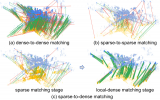匹配器
2.1 ICP點(diǎn)云精配準(zhǔn)
template < typename PointCloudPtr > bool ex_segmentor::icp_registration(PointCloudPtr &input_obj, PointCloudPtr &input_scene, PointCloudPtr &output_obj, Eigen::Matrix4f &result_transform, float &result_error, uint max_iteration, float max_distance, float ransac_th) // icp匹配
{ pcl::IterativeClosestPoint< PointXYZRGB, PointXYZRGB > icp; // icp對(duì)象
icp.setInputSource(input_obj); //設(shè)置輸入源點(diǎn)云
icp.setInputTarget(input_scene); //設(shè)置輸入目標(biāo)點(diǎn)云 //
Set the max correspondence distance to 5cm (e.g., correspondences with higher distances will be ignored) icp.setMaxCorrespondenceDistance(max_distance); //設(shè)置最大匹配距離 0.05 //
Set the maximum number of iterations (criterion 1) icp.setMaximumIterations(max_iteration); //設(shè)置最大迭代次數(shù) 50 // Set the transformation epsilon (criterion 2) //
icp.setTransformationEpsilon (1e-5); //1e-8 //
Set the euclidean distance difference epsilon (criterion 3) //
icp.setEuclideanFitnessEpsilon (0.000001); //1
icp.setRANSACOutlierRejectionThreshold(ransac_th); //設(shè)置RANSAC閾值
icp.align(*output_obj); // icp匹配 if (icp.hasConverged()) //如果icp匹配成功
{ result_transform = icp.getFinalTransformation(); //獲取最終變換矩陣
result_error = icp.getFitnessScore(); //獲取最終匹配誤差
return true; }
else
{ result_transform = Eigen::Matrix4f::Identity(4, 4); result_error = 1.0; return false; } }/** icp_registration(object_aligned, cluster, Final, icp_result_transform, icp_error);**/
2.2 FPFH點(diǎn)云粗配準(zhǔn)
void FPFH_generation(pcl::PointCloud<PointXYZRGB>::Ptr &input, FPFHCloud::Ptr &output) // FPFH特征提取 { // 首先,生成法線
pcl::NormalEstimationOMP<PointNormal, PointNormal> nest; // OMP線程數(shù)
pcl::PointCloud<PointNormal>::Ptr temp(new pcl::PointCloud<PointNormal>); //構(gòu)建暫時(shí)點(diǎn)云
pcl::copyPointCloud(*input, *temp); //拷貝點(diǎn)云
nest.setRadiusSearch(0.01); //設(shè)置半徑搜索范圍
nest.setInputCloud(temp); //設(shè)置輸入點(diǎn)云
nest.compute(*temp); //計(jì)算暫時(shí)點(diǎn)云 // 然后生成FPFH點(diǎn)云 pcl::FPFHEstimationOMP<PointNormal, PointNormal, FPFH> fest; // OMP線程數(shù)
fest.setRadiusSearch(0.01); // 0.025
fest.setInputCloud(temp);
fest.setInputNormals(temp); fest.compute(*output); }
template <typename PointType, typename PointCloudPtr> bool
FPFH_matching(PointCloudPtr &object, FPFHCloud::Ptr &object_feature, PointCloudPtr &scene, FPFHCloud::Ptr &scene_feature, PointCloudPtr &result_cloud, Eigen::Matrix4f &result_transformation) // FPFH粗配準(zhǔn)方法
{ pcl::SampleConsensusPrerejective<PointType, PointType, FPFH> align; //采樣一致性預(yù)排除算法
align.setInputSource(object); //設(shè)置輸入源點(diǎn)云
align.setSourceFeatures(object_feature); //設(shè)置輸入源特征點(diǎn)云
align.setInputTarget(scene); //設(shè)置輸入目標(biāo)點(diǎn)云
align.setTargetFeatures(scene_feature); //設(shè)置輸入目標(biāo)特征點(diǎn)云
align.setMaximumIterations(5000); // 設(shè)置最大迭代次數(shù)
align.setNumberOfSamples(7); // 設(shè)置采樣點(diǎn)數(shù)
align.setCorrespondenceRandomness(10); // 設(shè)置隨機(jī)匹配點(diǎn)數(shù)
align.setSimilarityThreshold(0.5f); // 設(shè)置相似度閾值
align.setMaxCorrespondenceDistance(0.01f); // 設(shè)置最大匹配距離
align.setInlierFraction(0.05f); // 設(shè)置內(nèi)點(diǎn)比例 align.align(*result_cloud); if (align.hasConverged())
{ result_transformation = align.getFinalTransformation(); //獲取最終變換矩陣 // pcl::console::print_info("Inliers: %i/%i , %in", align.getInliers().size(), scene->size(), object->size()); // return (float(align.getInliers().size()) / float(object->size())); return true; } // return 0.0f; return false; }/**
FPFHCloud::Ptr cluster_feature(new FPFHCloud); FPFH_generation(cluster, cluster_feature);
ROS_INFO("cluster_size : %d, feature size : %d", cluster->size(), cluster_feature->size());
bool FPFH_match_success = FPFH_matching<PointXYZRGB>(object_, object_feature_, cluster, cluster_feature, object_aligned, align_result_transform);**/
2.3 PCA點(diǎn)云粗配準(zhǔn)
void ex_segmentor::PCA_registration(pcl::PointCloud< PointXYZRGB >::Ptr
聲明:本文內(nèi)容及配圖由入駐作者撰寫(xiě)或者入駐合作網(wǎng)站授權(quán)轉(zhuǎn)載。文章觀點(diǎn)僅代表作者本人,不代表電子發(fā)燒友網(wǎng)立場(chǎng)。文章及其配圖僅供工程師學(xué)習(xí)之用,如有內(nèi)容侵權(quán)或者其他違規(guī)問(wèn)題,請(qǐng)聯(lián)系本站處理。
舉報(bào)投訴
-
匹配器
+關(guān)注
關(guān)注
0文章
6瀏覽量
5724 -
PCL
+關(guān)注
關(guān)注
1文章
32瀏覽量
13663 -
點(diǎn)云
+關(guān)注
關(guān)注
0文章
58瀏覽量
3786
發(fā)布評(píng)論請(qǐng)先 登錄
相關(guān)推薦
PCL點(diǎn)云庫(kù)介紹及項(xiàng)目配置方式
關(guān)于PCL點(diǎn)云庫(kù),大家百度的時(shí)候可以找到很多相關(guān)的介紹,反正一堆專(zhuān)業(yè)性概念,相關(guān)的技術(shù)層面以及一些強(qiáng)大的應(yīng)用敘述云云,不過(guò)關(guān)于這些小編實(shí)在不感冒,能先把這個(gè)工具好好用起來(lái)再說(shuō)吧。關(guān)于PCL
發(fā)表于 07-02 07:44
一種用于點(diǎn)模式匹配的改進(jìn)型譜方法
利用譜方法進(jìn)行點(diǎn)模式匹配的主要問(wèn)題是對(duì)點(diǎn)的位置噪聲比較敏感。為了提高譜方法對(duì)噪聲的魯棒性,該文在表示矩陣的構(gòu)建過(guò)程中采用高斯加權(quán)的近鄰矩陣對(duì)
發(fā)表于 03-31 09:44
?11次下載
改進(jìn)的特征點(diǎn)匹配算法
特征點(diǎn)匹配是計(jì)算機(jī)視覺(jué)中的關(guān)鍵步驟,在很多領(lǐng)域中都有著的重要應(yīng)用。通過(guò)對(duì)當(dāng)前圖像特征點(diǎn)匹配方法的研究,提取一種基于特征點(diǎn)的灰度量和幾何特征量
發(fā)表于 05-19 17:20
?0次下載

基于CCA的SIFT誤匹配剔除方法
針對(duì)尺度不變特征變換( SIFT)描述子僅利用特征點(diǎn)的局部鄰域灰度信息而對(duì)圖像內(nèi)具有相似灰度分布的特征點(diǎn)易產(chǎn)生誤匹配的問(wèn)題,提出一種基于典型相關(guān)分析( CCA)的sivr誤匹配剔除
發(fā)表于 12-29 14:44
?0次下載
分配器點(diǎn)涂技術(shù)的特點(diǎn)及方法介紹
分配器點(diǎn)涂技術(shù)是指將貼片膠一滴一滴地點(diǎn)涂在PCB貼裝SMD的部位上。根據(jù)施壓方式不同,常用的分配器點(diǎn)涂技術(shù)有三種方法。
無(wú)序抓取の3D點(diǎn)云匹配案例分享
這是一個(gè)實(shí)際拍攝的點(diǎn)云圖,經(jīng)過(guò)了坐標(biāo)系糾正變換,更方便查看點(diǎn)云位置。里面有一塊平面就是我們需要匹配的目標(biāo)點(diǎn)云。
點(diǎn)云匹配與ICP算法基本思想
ICP(Iterative Closest Point迭代最近點(diǎn))算法是一種點(diǎn)集對(duì)點(diǎn)集配準(zhǔn)方法。如下圖所示,PR(紅色點(diǎn)

圖像匹配應(yīng)用及方法
圖像匹配 應(yīng)用: 目標(biāo)識(shí)別、目標(biāo)跟蹤、超分辨率影像重建、視覺(jué)導(dǎo)航、圖像拼接、三維重建、視覺(jué)定位、場(chǎng)景深度計(jì)算 方法: 基于深度學(xué)習(xí)的特征點(diǎn)匹配算法、實(shí)時(shí)
一種多幅點(diǎn)云數(shù)據(jù)與紋理序列自動(dòng)配準(zhǔn)方法
方法將點(diǎn)云數(shù)據(jù)生成強(qiáng)度圖像,通過(guò)特征匹配得到紋理影像與強(qiáng)度圖像間的匹配關(guān)系,利用RANSAC算法進(jìn)行匹配
發(fā)表于 03-18 10:42
?5次下載

使用CUDA PCL 1.0加速Jetson的點(diǎn)云處理
很多Jetson用戶(hù)在自動(dòng)化解決方案中選擇激光雷達(dá)進(jìn)行定位和感知。激光雷達(dá)使用3D點(diǎn)云描繪周?chē)目臻g環(huán)境。點(diǎn)云可以高精度長(zhǎng)距離采樣物體表面信息以便于上層應(yīng)用的障礙感知、繪圖、定位和

SDMNet:大規(guī)模激光雷達(dá)點(diǎn)云配準(zhǔn)的稀疏到稠密匹配網(wǎng)絡(luò)
為了處理上述的問(wèn)題,我們提出了SDMNet,一種新的由稀疏到密集的針對(duì)大規(guī)模室外點(diǎn)云的配準(zhǔn)方法。稀疏到稠密匹配方案如圖1(c)所示。具體而言,我們將配準(zhǔn)問(wèn)題分為兩個(gè)階段,即稀疏

Lane Tech PCL:通過(guò)語(yǔ)音命令的東西分配器
電子發(fā)燒友網(wǎng)站提供《Lane Tech PCL:通過(guò)語(yǔ)音命令的東西分配器.zip》資料免費(fèi)下載
發(fā)表于 06-26 11:36
?0次下載

基于深度學(xué)習(xí)的點(diǎn)云分割的方法介紹
基于視圖和投影的方法、基于體素的方法、無(wú)序點(diǎn)云的方法、有序點(diǎn)
發(fā)表于 07-20 15:23
?3次下載
點(diǎn)云濾波與匹配進(jìn)階干貨收藏
之前作者專(zhuān)門(mén)為點(diǎn)云匹配寫(xiě)了幾篇博客,但是我們發(fā)現(xiàn)最近幾年有更多的新方法已經(jīng)在不斷地被使用。
同時(shí)之前有些內(nèi)容也沒(méi)有很好的概括,所以這里我們將作為一篇進(jìn)階文章來(lái)介紹這些
PCL中基礎(chǔ)下采樣介紹
顧名思義,隨機(jī)下采樣就似乎在原始點(diǎn)云中隨機(jī)采樣一定點(diǎn)數(shù)的點(diǎn)。這種方法最終得到的點(diǎn)云數(shù)量也是固定的。 pcl::PointCloud ::Pt





 PCL匹配器濾除點(diǎn)云方法
PCL匹配器濾除點(diǎn)云方法










評(píng)論